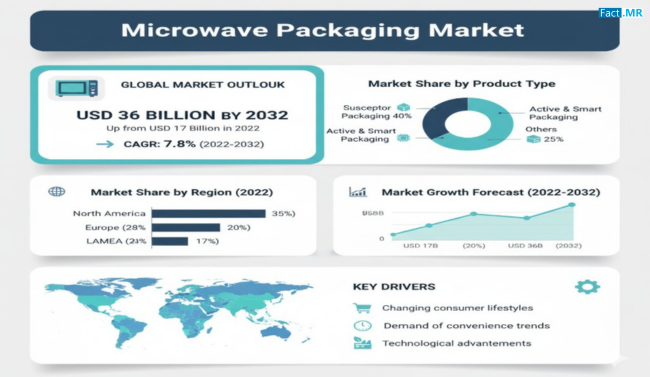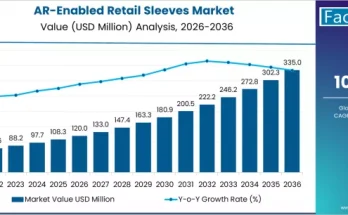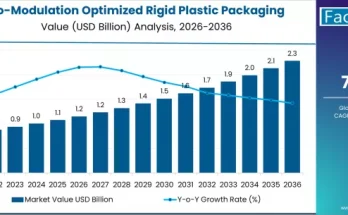In today’s fast-paced world, convenience has become a key driver in consumer purchasing decisions — particularly in the food and beverage sector. The microwave packaging market is at the forefront of this shift, evolving as consumers demand quick, easy-to-prepare meals that don’t compromise on quality or sustainability. The rise in urban lifestyles, growing employment rates, and increasing reliance on ready-to-eat or on-the-go food products have accelerated the need for efficient packaging solutions compatible with microwave heating.
Microwave packaging plays a vital role in preserving the taste, texture, and nutritional integrity of food while ensuring safety during the heating process. This market is witnessing strong innovation trends, as packaging manufacturers develop advanced materials and designs that cater to changing consumer habits and stringent environmental regulations.
Market Overview
Microwave packaging refers to specially designed containers, trays, pouches, and wraps that can safely withstand microwave heating. These solutions are engineered to distribute heat evenly, minimize leakage, and prevent chemical migration during heating. The packaging not only ensures food safety and convenience but also enhances the shelf life of products.
Food manufacturers are increasingly using microwaveable packaging for a wide range of applications, including frozen meals, snacks, soups, dairy products, and beverages. The market is characterized by a growing preference for single-serve portions and portion-controlled packs, aligning with the expanding population of working professionals and students who prioritize convenience in meal preparation.
In addition to convenience, sustainability is becoming a critical consideration. The industry is gradually shifting from traditional plastic-based materials toward biodegradable, recyclable, or compostable alternatives that align with global environmental goals.
Regional Insights
North America remains a key market for microwave packaging, driven by a strong processed food industry and widespread adoption of convenience-oriented lifestyles. Technological advancements in packaging formats, such as dual-ovenable trays and self-venting films, have further contributed to the region’s growth.
Europe showcases a strong focus on eco-friendly packaging solutions, propelled by regulatory frameworks aimed at reducing plastic waste. Manufacturers are actively developing sustainable alternatives that comply with circular economy principles, ensuring minimal environmental impact while maintaining product performance.
Asia-Pacific is emerging as a rapidly growing region, fueled by expanding urban populations, rising disposable incomes, and increasing penetration of ready-to-eat food products. Countries such as China, India, and Japan are witnessing strong adoption of microwave packaging in both domestic and commercial food sectors.
Latin America and the Middle East & Africa are gradually adopting microwave packaging solutions as urbanization accelerates and food delivery services expand across metropolitan areas.
Key Trends and Developments
- Sustainability and Green Packaging Solutions
The industry is undergoing a shift toward sustainable materials such as paper-based composites, bio-based plastics, and recycled polymers. Manufacturers are focusing on developing packaging that can be easily disposed of or reused, minimizing environmental impact. - Smart Packaging Technologies
Integration of smart packaging elements such as heat indicators, self-venting lids, and steam-control valves enhances consumer safety and convenience. These innovations ensure optimal heating results and improve overall food quality. - Expansion of Ready-to-Eat and Frozen Foods
The growing popularity of microwaveable meals, driven by evolving consumer lifestyles and time constraints, has increased demand for advanced packaging that supports faster and more uniform heating. - Collaborations and R&D Investments
Companies are forming partnerships with material science innovators and research institutions to develop next-generation packaging solutions. These collaborations focus on improving heat resistance, extending shelf life, and meeting recyclability targets. - Regulatory and Compliance Pressure
Governments across the globe are enforcing stricter regulations regarding food safety and environmental sustainability. Packaging manufacturers are adapting by investing in compliance-ready materials and labeling transparency.
Applications and End-Use Outlook
The microwave packaging market serves multiple industries, with food and beverages being the most prominent. Within this category, sub-segments such as ready-to-eat meals, frozen foods, and instant snacks dominate the landscape.
- Ready-to-Eat Foods: Consumers prefer packaging that allows quick heating and consumption without the need for additional utensils or preparation steps.
- Frozen Meals: Microwave-safe trays and pouches are engineered to preserve freshness and flavor while enabling direct heating from frozen conditions.
- Dairy and Beverages: Packaging formats like microwaveable bottles and pouches are becoming increasingly popular for reheatable dairy drinks and soups.
- Food Service and Delivery: The expansion of online food delivery platforms has amplified the need for packaging that maintains temperature and texture consistency during transit.
Furthermore, innovations in dual-ovenable and multi-compartment packaging designs are enhancing product differentiation, helping brands deliver superior consumer experiences.
Challenges and Opportunities
Despite its rapid growth, the microwave packaging market faces challenges related to cost pressures, recyclability, and compliance with varying regional safety standards. Ensuring that materials remain stable under high heat while being environmentally responsible poses a complex manufacturing challenge.
However, opportunities lie in the development of bio-based films, lightweight packaging materials, and nanotechnology-enhanced coatings that offer superior barrier properties. The increasing focus on smart and digital packaging solutions, such as QR codes for recycling information and temperature-tracking labels, is also opening new growth avenues.
Conclusion
The microwave packaging market represents a crucial link between evolving consumer lifestyles and sustainable innovation in the food packaging sector. As demand for convenience continues to rise, manufacturers are under growing pressure to create solutions that are not only efficient but also environmentally responsible.
From smart packaging features to eco-friendly materials, the industry is aligning itself with global sustainability goals while delivering the convenience modern consumers expect. By adopting forward-thinking strategies and investing in research-driven solutions, companies can position themselves as leaders in this dynamic, rapidly evolving market.
Browse Full Report – https://www.factmr.com/report/microwave-packaging-market



